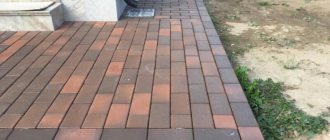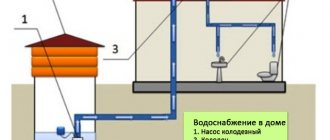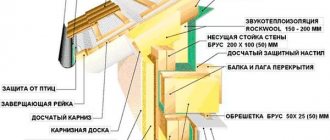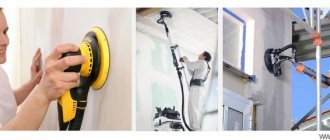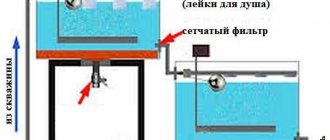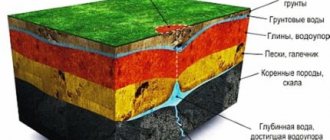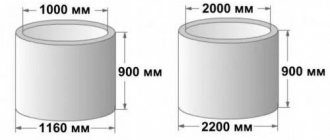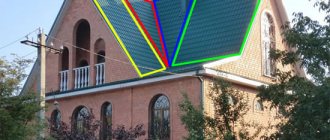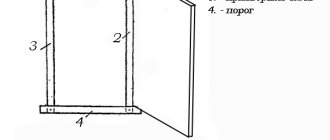It is difficult to call a cottage in which there is no water supply modern and comfortable for living. Walking with a bucket to a well or pump is something out of fairy tales or old grandmother's stories today. There must be running water in a private home. And you can do it yourself by organizing a water supply from the same well. The situation is even simpler when it is possible to connect to the village centralized network. In this case, it is enough to install only the internal part of the water supply system.
Water supply systems
Water supply to country houses is:
- centralized;
- decentralized.
In the first option, the water source is the water supply network common to the entire village. To connect a private home to it, you must contact the resource supply organization and obtain specifications for connection. The subsequent insertion into the centralized pipeline will be carried out by the installers of this company, and the distribution of the water supply through the residential building can be done independently.
Home water supply options
In the second option, water enters the house from a well, borehole or river. If such water intake is done on your own property, then you will not need to obtain permits or coordinate anything with government agencies. However, all issues of quality and compliance of the life-giving moisture entering the cottage fall on the shoulders of the home owner.
What does the price of the service depend on?
The price of the service may vary widely, depending on many factors. If there is a centralized water supply within easy reach of the house, then it is enough to simply cut into it and supply water to the building. Drawing water from a well is the most inexpensive service. The most expensive but most convenient option would be drilling a well . Also, the price will depend on the footage of the work being done, both in depth and length, and on the materials used. The service of running water directly into the house will cost additional costs.
Plumbing system in a private house
The plumbing system of a private house consists of an external and an internal part. The first includes a street water supply from a water intake or village network and directly a well or well with a pump (if this is a decentralized autonomous option). The second includes the cold water and hot water pipelines located in the house, as well as filters, pumps, fittings and taps.
External part of the water supply system of a private house
How to develop a plumbing diagram
In order for everything to work out correctly in the end, before installing the water supply it is necessary to carefully work out the layout of its installation on the street and its wiring in the cottage. If this project is done correctly, it will avoid many problems during installation work and subsequent operation of the assembled water supply system.
Water supply scheme for a private house
When developing such a water supply scheme, the following is calculated:
- number of water supply points in the house;
- the need and number of collectors;
- pump power and water heater capacity;
- pipe sizes;
- characteristics of shut-off valves.
Plus, you select the option of pipe routing (collector or sequential) and the placement of all elements of the water supply system in a private house. At first glance, it is easier to install the same electrical wiring in an apartment or a ventilation system. However, both have their own nuances. And even with the slightest mistakes, there will be many problems in all cases.
Exterior works
After preparing all the documentation and purchasing the necessary material, you can begin creating a water supply system in a private house. The first stage includes external work. First of all, decide on the point of insertion into the central system. This data can be obtained from the design documentation issued by the water utility.
Recent Entries
Chainsaw or electric saw - what to choose for the garden? 4 mistakes when growing tomatoes in pots that almost all housewives make Secrets of growing seedlings from the Japanese, who are very sensitive to the soil
A trench is dug to the connection point. Its depth should be below the soil freezing level. Otherwise, in winter the pipes will freeze, and when it warms up you will have to start all the work again.
You can dig trenches with your own hands, provided that the distance to the central communications is not too great. Otherwise, you will have to hire special equipment. If the soil is simple (no clay or stones), then you can do without a continuous trench. It is enough to dig a few holes and use a hose through which water is supplied under pressure. The jet will wash the soil and make a passage for laying pipes . This method significantly speeds up and reduces the cost of creating a water supply system in a private home.
Some owners of private houses do not dig such deep trenches. This happens either because the soil is heavy or because the depth is too great. In this case, thermal insulation materials can help. Today on the market you can find modern insulation materials that are placed on the pipe in the form of a “shell.” This material can reliably protect your water supply from winter cold. But all the same, the pipes will have to be deepened at least a meter into the ground.
When insulating the water supply system, special attention should be paid to the entry points of the system into the house. If you have a basement, then there should be no problems. In this case, the pipes will be in the ground and will not freeze. It’s another matter if there is no basement, and when approaching the house, communications rise to the surface. It is at this point that pipes most often freeze. communications here especially carefully.
Before laying pipes in the trench, it is necessary to make a cushion. For this, crushed stone and sand are used. Such additional protection will help drain groundwater away from your communications, and thereby prevent them from freezing.
It is advisable to install a well at the point of insertion into the central water supply. In this case, you will have the opportunity to block communications for repairs. In addition, the water utility will definitely force you to install a meter (today this rule applies everywhere). Moreover, the device should be located as close as possible to the connection to the central water supply.
Features of pipe selection
Pipes for home water supply can be made of plastic, steel, copper or metal-plastic. Copper will cost the most. But pipelines made from it are not subject to corrosion and deformation during heating (cooling), and they are also not afraid of impurities in water and water hammer.
The easiest way to install plastic options, however, high and low temperatures are strictly contraindicated for them. It is recommended to choose plastic for installation inside the house, and choose steel for the street. Steel pipes are more difficult to connect (welding is required). But they are more reliable, although they are susceptible to rust.
The internal diameter of the pipes is selected based on the estimated volume of water consumption by plumbing fixtures connected to a specific section of the water supply system. In this case, a tubular product with an internal cross-section of 25 mm is capable of flowing about 30 l/min, and with a cross-section of 32 mm – about 50 l/min. Typically, these two sizes are most often chosen for installing an in-house plumbing system. If you take pipes of a smaller diameter, they will make noise, since to increase their throughput you will have to increase the water pressure.
Types of pipes for water supply
To install an external section of water supply with your own hands, they are usually taken from a pipe with thermal insulation with a cross-section of 32 mm. This pipeline will lie in the ground, so special attention must be paid to its insulation. He shouldn't freeze in the winter.
Video
Installation of a loop water supply system. The water supply contains Legionella bacteria, which can multiply and cause the water to become hazardous to health (and even cause death). This risk can be eliminated if you install a water supply system using a loop system. The video contains detailed installation instructions for people who care about drinking water hygiene.
A well with a secret and summer water supply with your own hands. A stunning video about how a woman found water on her property using a twig, and her husband dug a well and installed an ingenious water supply system with his own hands.
Installation of water supply and drainage systems using a pumping unit. The plot describes in detail how to bring water from the central water supply into the house and create a distribution system for the floors. from it there is water supply to the house, a distribution system for the floors. A special feature of this system is a pumping unit for maximum comfort.
Polypropylene pipes: types, fittings, components. Master class on soldering pipes. A specialist helps you choose cold water pipes, fittings and components for them. What to look for when choosing, what is important, what is not, and how not to overpay for a brand and win in quality. The video also shows how to solder pipes with your own hands using simple tools.
A house made of aerated concrete blocks and the collective wisdom of forum members: organizing water supply from a well. This energy-independent house was built by FORUMHOUSE specialists, and the video explains in detail how the water supply and electrical systems are arranged in it. How is the house's water supply from a well arranged?
Recommendations for system installation
Installing water supply in a cottage in seven steps:
- Marking pipe routing, as well as installation locations for equipment and plumbing.
- Making holes in the walls for the pipelines to be laid.
- Connecting pipes using fittings or welding.
- Connecting shut-off valves.
- Installation of a water heater (boiler) and pumps with their connection to the assembled water supply system.
- Installation of plumbing.
- Starting the water and checking for leaks.
It is recommended to leave about 15–20 mm of empty space between the wall and the pipe. This will make it easier to repair the plumbing later if necessary. Also, each branch from the riser to the plumbing should have its own shut-off valve. This way, in the event of an emergency, you won’t have to turn off all the water in a private house, leaving household members completely without it for several hours or even a couple of days.
Which pipe and fittings to choose
As noted above, it is more rational to lay the pipeline using HDPE pipes, which are the most common. The distinctive features of this type of pipe are as follows:
- The products are designed to supply cold water with a temperature from 0 to 40 C;
- The maximum pressure range depends on the diameter and can reach up to 25 atmospheres.
- HDPE pipeline has a lower hydraulic resistance compared to metal products, which prevents the formation of salt deposits and silt on the walls during water circulation.
- Connection to the main line and pipes inside the house is made using compression fittings, ensuring ease of installation, high reliability and tightness of the connection.
- The pipe is supplied in coils of various lengths - this facilitates its transportation and installation.
- The service life of a HDPE pipeline without loss of its physical and chemical properties is about 50 years.
- Unlike metals, synthetic materials are resistant to corrosion and most harsh chemicals.
- Low-density polyethylene has low thermal conductivity - this prevents the water in the pipes from freezing in cold weather.
- Freezing of pipes rarely leads to rupture - they stretch without losing their integrity.
- Currently, the most common brands are PE80 or PE100, the latter has a high density and is used for the installation of water mains.
Rice. 10 HDPE pipes and fittings - appearance
You can officially connect to the main water supply in a private house after drawing up and signing a large number of documents that must be submitted to the water utility to draw up an agreement on connection to the water supply system. To save money, some of the work can be done with your own hands within an individual site - this is not prohibited by law if the installation is carried out in accordance with the technical conditions.
Connecting the pumping station
The pump or pumping station is installed in a caisson above the well, in the basement or in an outbuilding next to the well. This equipment is sensitive to severe frosts, so it should be located in an insulated, or even better, heated place.
Otherwise, there is a risk that the water inside it and nearby pipes will simply freeze. It is also possible to install a submersible pump directly into the well.
However, pressure switches and other automation will still require some kind of insulated space in the borehole head or room in the house for them to work correctly.
Schematic diagram of pumping station connection
Hydraulic accumulator
To ensure that the pressure in the cottage’s autonomous water supply system is always constant, a hydraulic accumulator is included with the pump. It not only allows you to control the pressure in the taps, but also reduces wear on pumping equipment. The latter turns on less often. This only happens to fill the accumulator tank, and not every time you open the faucet valve in the kitchen.
If you don’t want to install a hydraulic accumulator, then you can get by with a regular storage tank of 0.5–1 cubic meter installed in the attic. This scheme allows you to do without complex and expensive equipment. At the same time, the pressure in the taps remains quite stable and constant.
Connection diagram for hydraulic accumulator
Water purification
If the quality of the water leaves much to be desired, then the water supply will have to be supplemented with a water purification system. At a minimum, you need a coarse filter. It will remove grains of sand and other large suspended particles from the water flow.
Additional filters are installed after the water has been analyzed for the chemical composition of the impurities present in it. If the content of iron or calcium is high, some treatment devices will be needed, and with increased hardness, others will be needed.
Water purification scheme in a private house
Advantages of central water supply
Benefits when connecting to a central water supply:
- you will get rid of significant financial costs for pumping equipment (it costs more than two pennies!);
- drilling, pumping and maintaining a well in working condition also means money, time and worries;
- Centralized water supply is a type of activity with a certificate, which guarantees you an uninterrupted supply of water, maintaining (without your efforts) normal pressure in the pipes and drinking quality of water.
You can supply water to a private home with the help of specialists (but this is a financial cost) or with your own, the choice is yours.
Price issue
The cost of the entire complex for external water supply depends on many factors, including the following:
- route length;
- pipe material;
- depth of placement - the volume of excavation work depends on this;
- local rates, etc.
The order of the numbers is as follows:
- water supply project – 5 thousand rubles;
- receiving technical conditions – 4-5 thousand rubles;
- approvals - 12 thousand rubles;
- cost of pipes, water meter, components – 5-10 thousand rubles.
- box with the fee for connecting to the network - 15 - 50 thousand rubles;
- excavator work – 5-10 thousand rubles;
- network laying (in complex) – 1.7 – 2.6 thousand per 1 rm.
Tariffs for water supply vary greatly by region, and in addition to the cost of the connection itself, they also charge the tariff rate for the length of the water supply network. Depending on the climate zone, it will be necessary to provide additional thermal insulation measures, and this applies to both the entry into the house and the exit from the well, and the pipeline itself with water supply equipment. Backfilling of trenches is usually done with sand (partially or completely), and this is another plus to the total amount.
The asking price can range from 80 to 120 thousand rubles.
How not to break the law
To connect to a centralized water supply, you will have to prepare a whole bunch of documents and obtain technical conditions for connection. Without these pieces of paper you cannot cut into a pipe without permission. This will be discovered sooner or later and considerable fines will follow for arbitrariness and water consumption. Here, all connection issues should be resolved exclusively through the organization that controls the water utility.
Types of water sources for a private home
With a well and a borehole, the situation is radically different. There is no need to collect permit papers here. You can organize such a water intake on your site at any time. Moreover, it is not even necessary to invite specialists to dig a well. If you know exactly at what depth the water lies, then getting to it with your own hands if you have the skills to handle a shovel and follow simple rules will not be difficult.
Connection diagram for water supply to a private house with artesian water
The only limitation on the well is if it is made deep artesian. In this case, there is no way without permission. Such water withdrawal requires approval from government agencies. This sewerage installation in a private house can be done in any way without control from the authorities. This will not work with an artesian well.
Connecting a private house to the central water supply - sequence of work
The house can be connected to the central highway without waiting to receive a plan for laying the pipeline; there are several ways to solve this problem.
Although the prerogative for connecting the water supply and tapping into the water main belongs to the water utility, which will have to shell out a considerable amount for one and a half to two hours of work, this work can be carried out with the help of specialists in other organizations or hired workers, subject to technical conditions. Connection to the water supply of a private house must be made in the following order:
- The method of cutting into the main line is selected; the simplest option is to use overhead clamps on the main line made of plastic or steel pipes. It should be noted that tapping into a pipeline under pressure involves the use of special devices based on the technique of drilling the pipeline through overhead clamps.
- The pipeline material is selected, which must be ordered in length from the point of water intake to the house; usually preference is given to light, durable and corrosion-resistant pipelines made of low-pressure polyethylene HDPE.
- The necessary metering devices and compression fittings are purchased, which are the main elements of the fittings for connecting the HDPE pipeline.
Rice. 7 Laying a pipeline with your own hands - carrying out excavation work
- A well is made of concrete rings in the place where the cutting is to be carried out; similarly, a hole of the required depth is dug near the foundation of the house, in which a hole is drilled to insert the pipe into the house.
- Using special equipment (trenchers, small excavators) or with your own hands, a trench of the required depth is dug into which the HDPE pipeline is placed. After adding sand to the trenches, the pipeline laid on a sand cushion is buried; at shallow burial depths, cable heating of the pipeline or thermal insulation is used, backfilling with non-heat-conducting materials (expanded clay).
- The HDPE pipe is connected to the main line through a fitting with a shut-off valve along with sealed metering devices, after which water can be supplied to the house.
